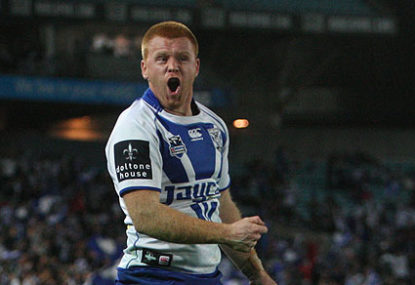NRL Round 8 Talking Points: The kick-off is on borrowed time, so what replaces it?
Round 8’s NRL was a weekend of domination, with an average win margin of 21 points and some teams seeing their finals hopes really…

The 2013 NRL season is almost upon us. We fans can’t wait to see the first kick-off of the year.
We’ll be on the edge of our seats watching the first hit-up and we’ll settle back when the ref awards our team’s first try.
In the interim we can expect to start to see promotional ads on Channel Nine and Fox Sports start to ramp up.
Judging by the ads already running for the NRL All-Stars exhibition match we can expect to see the usual fast-paced highlight package style clips of big hits, familiar stars sprinting, grimacing and diving for a try.
There’ll be a few quick shots of cheerleaders dancing, shots of banners waving and all explosions, flames, sparks and fireworks you could possibly want to overlay.
I wonder which middle-of-the-road, safe, hard rocker from the 80s will be press-ganged into service this year.
Boring!
Presuming the above is as true for 2013 as it has been for the last 20 years, I wonder then the NRL will start to take some more control over the way the game is marketed and presented by its broadcast partners.
The NRL operates in a predatory media environment. Careers are sustained by the muckraking and sensationalising of every petty misdemeanour. Faux offence is taken at every opportunity.
Spluttering, blustering fiction pieces are dashed off, blasting the code and its individual personalities based on nothing but personal feuds and vendettas.
The NRL has taken many strong and effective steps to rein in players’ bad behaviour and the results have shown pretty well over the last couple of seasons.
The media has had to draw some ludicrously long bows in order to get the outrage piece or ‘code in crisis’ story they constantly need.
If the Channel Nine news department wants to pretend their reporter was shocked and offended while intruding uninvited on a club’s Mad Monday party then there’s not much anyone can do to stop them.
But if the best its marketing department can concoct is the perpetual ad outlined above, the trade-off isn’t worth it.
The public are left with the impression that rugby league is a game played by violent, brainless thugs, best avoided if spotted in public and who get paid vastly more than they deserve for bashing each other and falling over a line of white paint once in a while to the sounds of some non-threatening rock and fireworks exploding.
Does the NRL want its product marketed in a way that suits the TV stations, or in a way that suits itself?
The game has been entwined in the fabric of our sporting landscape and our broader culture for a century and more.
The people who reach its top tiers are the same as the people who never progress past under-14 reserves.
The best players’ mothers are the same as the mums who drive their kids to games and bandage their scraped knees.
The same fathers school their kids in which teams to hate. They explain the game’s rules around mouthfuls of Sunday afternoon beers and beer-nuts.
They kick a Steeden in the park and share in-depth opinions with their mates at the pub and on emails.
Tipping comps are run and won. Fantasy league comps reveal the statistical worth of players. We stand behind our nation’s mighty Kangaroos as we watch them take on the best from around the world.
In other words, there is a culture that underpins the pointy end of the code. It has deep roots in Australia’s history.
It has reinvented itself time and again and withstood devastating attacks from within and without.
It evolves and it provides a thread that can be traced back to Provan, Churchill, Dally-Messenger and back into the mists of time.
We participate in the on-field battles by proxy and we wear the weekend’s results either with pride or shame. Our love of the code fulfils a human need for an emotional outlet that is equal parts love, hate, triumph and despair.
All of these things (and much more) form the ‘real’ rugby league. The NRL is just the professional aspect of this culture. As such it is obliged to cultivate and steer the culture that sustains it.
The NRL needs to encourage its broadcast partners to make more of the code’s rich history and highlight the fans’ life-long love affair with their players, club, state and country. If they don’t, the game’s culture will continue to be hollowed and emptied.